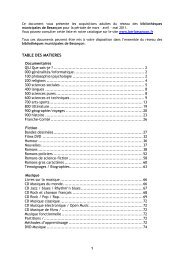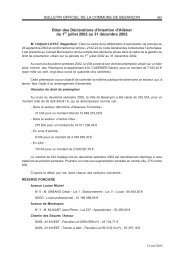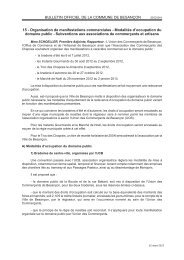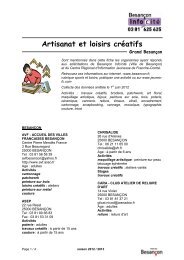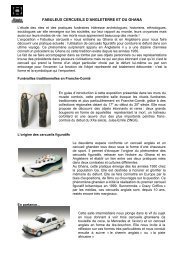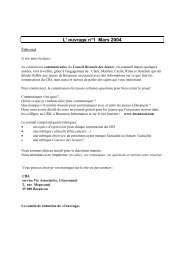An inventory of works within the city walls - Besançon
An inventory of works within the city walls - Besançon
An inventory of works within the city walls - Besançon
You also want an ePaper? Increase the reach of your titles
YUMPU automatically turns print PDFs into web optimized ePapers that Google loves.
13<br />
11<br />
Quai Vauban<br />
Seventeenth century<br />
The <strong>works</strong> on <strong>the</strong> quay on ei<strong>the</strong>r<br />
side <strong>of</strong> <strong>the</strong> porte Battant, on <strong>the</strong> side<br />
<strong>of</strong> <strong>the</strong> loop, started in 1691 under<br />
<strong>the</strong> supervision <strong>of</strong> engineer Isaac<br />
Robelin, director <strong>of</strong> <strong>the</strong> Franche-Comté<br />
fortifications, against <strong>the</strong> advice <strong>of</strong><br />
Vauban who only wanted<br />
to build a simple rampart. The<br />
project, which involved realigning<br />
<strong>the</strong> façades <strong>of</strong> <strong>the</strong> houses, would<br />
never be completed due to lack <strong>of</strong><br />
funds. To celebrate <strong>the</strong> glory <strong>of</strong> Louis<br />
XIV, a triumphal arch was erected on<br />
<strong>the</strong> bridge between 1691 and 1693.<br />
The base <strong>of</strong> <strong>the</strong> gate had a defensive<br />
function: two batteries with casemates<br />
were <strong>the</strong>re for firing upstream and<br />
downstream and to prevent <strong>the</strong> Doubs<br />
from being crossed. In poor condition,<br />
<strong>the</strong> arch was knocked in 1776.<br />
Cordeliers flank casemate<br />
Seventeenth century<br />
Chamars Promenade / Quai Vauban<br />
The Cordeliers flank is a reinforced<br />
vaulted artillery-pro<strong>of</strong> casemate<br />
for three pieces <strong>of</strong> artillery which<br />
could aim low fire over <strong>the</strong> Doubs,<br />
between <strong>the</strong> Cordeliers tower and <strong>the</strong><br />
Arenes bastion situated on <strong>the</strong> o<strong>the</strong>r<br />
bank. The entrance is no longer visible<br />
as <strong>the</strong> buildings <strong>of</strong> <strong>the</strong> Lycée Pasteur<br />
school are in front <strong>of</strong> it: perhaps <strong>the</strong><br />
entrance to <strong>the</strong> casemate has been<br />
buried under <strong>the</strong>se buildings or under<br />
<strong>the</strong> embankment next to <strong>the</strong> road.<br />
Casemate on <strong>the</strong> Poitune flank<br />
12<br />
Seventeenth century<br />
Quai Vauban (entrance at <strong>the</strong> corner <strong>of</strong> <strong>the</strong><br />
rue du Lycée and <strong>the</strong> rue Claude Pouillet<br />
is currently occupied by a restaurant)<br />
12<br />
Saint-Esprit bastion<br />
14<br />
Seventeenth century<br />
Corner <strong>of</strong> Quai Vauban/rue Jean Petit<br />
This was built between 1692 and 1695<br />
and levelled in 1895. In its left flank<br />
<strong>the</strong>re is a casemate which had two<br />
pieces <strong>of</strong> artillery for directing low<br />
fire over <strong>the</strong> Doubs downstream.<br />
Its right-hand flank included<br />
a slope down to a watering place.<br />
This was a vaulted passage in <strong>the</strong><br />
ramparts which enabled horses to be<br />
taken to drink <strong>the</strong> river water.<br />
The passage was equipped with a<br />
firing arcade and was closed by gates.<br />
14<br />
This casemate had <strong>the</strong> same<br />
function as <strong>the</strong> Cordeliers casemate,<br />
but only had two canons.<br />
11



